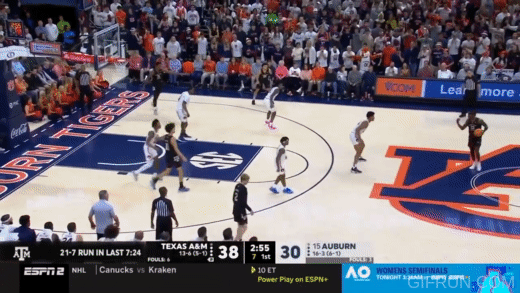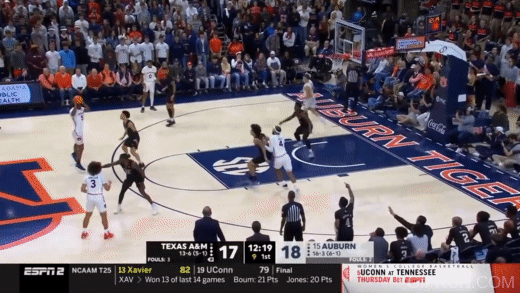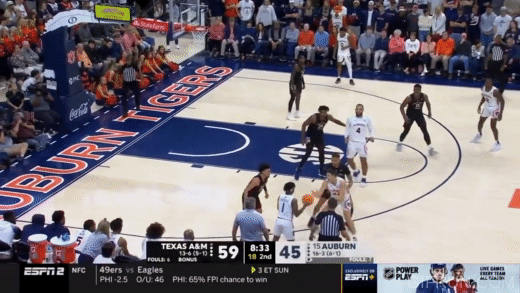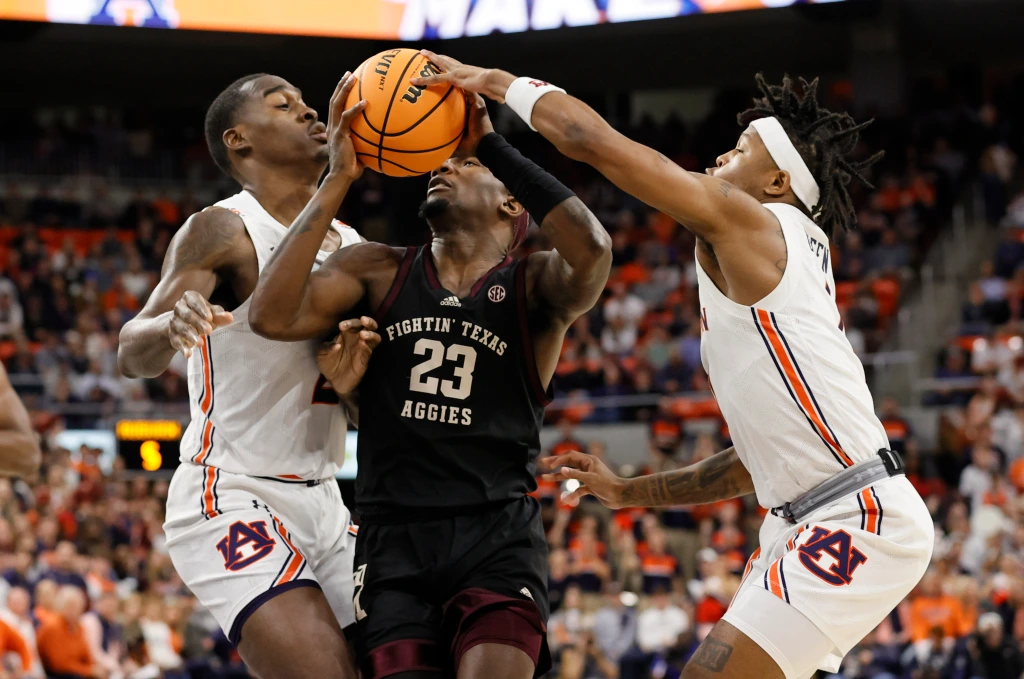SEC play has resumed, which means it is still must-win time for the Hogs. With a home game and a road trip to a bad South Carolina team up next, the Hogs absolutely must go 2-0 this week.
Meet the Aggies
Texas A&M caught fire down the stretch last season, but it wasn’t enough to make the NCAA Tournament, forcing the Aggies to settle for an NIT Final Four trip. With most key players returning, the Aggies had high expectations and started the season in the AP top 25.

But just like last year, a poor non-conference resume has Texas A&M behind the 8-ball. They lost to Murray State, Colorado, Boise State, Memphis, and Wofford out of conference, with zero good wins to show for it.
However, since conference play has started, they’ve caught fire, particularly on defense, where they’ve only allowed 70+ points once and held three opponents under 60.

Model pick: Arkansas 74, Texas A&M 69.
Scouting Report
Texas A&M’s offense looks similar to Arkansas’. The Aggies struggle to hit jump shots, so they are very aggressive getting to the rim. They crash the offensive boards and draw fouls.
Defensively, the Aggies run the same no-middle defense that Arkansas just saw against Baylor. They will keep you away from the rim at the cost of some offensive rebounds and some open 3-pointers. Unlike Baylor, the Aggies have had some issues with foul trouble in their aggressive scheme.
Starters
Texas A&M
- Julius Marble, PF, 6’9 (+1.6 BPM, 94 RAPM)
- Henry Coleman III, SF, 6’8 (+3.3 BPM, 95 RAPM)
- Dexter Dennis, SF, 6’5 (+2.5 BPM, 96 RAPM)
- Tyrece Radford, SG, 6’2 (+5.8 BPM, 86 RAPM)
- Wade Taylor IV, 6’0 (+8.4 BPM, 99 RAPM)
Arkansas
- Makhi Mitchell, PF, 6’9 (+6.8 BPM, 70 RAPM)
- Jordan Walsh, SF, 6’7 (+1.9 BPM, 100 RAPM)
- Ricky Council IV, CG, 6’6 (+4.5 BPM, 97 RAPM)
- Devo Davis, SG, 6’4 (+1.1 BPM, 94 RAPM)
- Anthony Black, PG, 6’7 (+4.4 BPM, 100 RAPM)
For Texas A&M, the backcourt provides all the danger, with Taylor and Radford as the main players to watch. Taylor is a rather obvious draw for Devo Davis: he’s the Aggies’ only legitimate 3-point threat and leads the team with a massive 29% usage rate. He’ll take just over half his shots from beyond the arc, but he’s also an elite foul-drawer (31% free throw usage) when he tries to go inside. As the main ballhandler, he also boasts an excellent 24% assist rate. Shutting him down takes away a lot of Texas A&M’s offense right off the bat.
Radford is the second-biggest threat. He’s also high usage (23%), but he’s a little more challenged as a shooter. Only about one-third of his shots will come from beyond the arc, and he’s only hitting at a 33% clip from out there. Like Taylor, he gets to the line a ton (30% free throw usage) and that’s largely how he makes his living.
I feel reasonably confident that Devo can limit Taylor, but Radford is a bit concerning, as Black has had some issues with small, quick guards that can win off the dribble. And the massive foul-draw rate of both Taylor and Radford is exceptionally dangerous given Arkansas’ known issues with defending without fouling.
The final perimeter starter is Dennis, a lower-usage guy who mostly helps space the floor. Most of his shots are 3-pointers, but he’s only hitting 26% of them. Despite being only 6’5, he leads the team in defensive rebounding rate (17%).
On the interior, you have Coleman and Marble, whose primary value is their defense. Their ORAPMs are 60 and 70. Both shoot just above 50% from the floor, all around the rim, but neither are amazing at drawing fouls. Coleman is a dangerous offensive rebounder (10%). Marble has a 23% usage rate when he’s on the floor, but his minutes are limited by foul trouble: he gets just 0.59 kills per foul and averages almost six fouls per 40 minutes on the floor.
Bench
Texas A&M’s starting five is among the best in all of college basketball, but their bench is quite bad, especially at the guard position. Former Hog KK Robinson hasn’t been able to crack the rotation, which is a shame for him, because there certainly was an opportunity for him.
Taylor’s replacement is 6’2 senior Andre Gordon, whose RAPM of 48 is a big dropoff from Taylor’s 99. Gordon is hitting just 33% from beyond the arc, doesn’t draw fouls (12% free throw usage), and turns it over on 20% of his possessions. And that’s on offense: his DRAPM of 39 is the worst on the team.
Off the ball, 6’4 sophomore Manny Obaseki grades as the Aggies’ worst player. Despite hitting 41% from beyond the arc (on limited attempts), he’s a poor rebounder, poor defender, and has a team-worst 27% turnover rate.
Rounding out the top 8 is 6’7 Mississippi State transfer Andersson Garcia, who actually grades as pretty good. He leads the team with an excellent 16% offensive rebound rate, but he’s extremely foul-prone, which will limit his minutes.
When Texas A&M has the ball

Offense is the Aggies’ specialty. They are not a particularly fast-paced team overall, but their halfcourt sets are relatively quick, helping them rank 126th in average possession length despite being only 187th in transition rate. Their halfcourt offense is where they are most dangerous.

The obvious threat here is that free throw number. Texas A&M isn’t an elite shooting team (95th in effective field goal %, 290th in 3-point field goal %), so they will get to the rim (58th in rim usage), crash the offensive boards (22nd in offensive rebound %), and draw fouls (2nd in free throw rate). The Hogs can certainly defend around the rim (31st) and clear defensive rebounds (78th), but they simply allow too many shots around the rim (320th), which gives the Aggies an opening to get the Hogs in a lot of foul trouble.
As we saw above, the risk is the Aggie guards, not the forwards. Taylor and Radford are foul magnets and make a living at the line. If you can keep them out on the perimeter and force the forwards to handle the ball around the rim (easier said than done), the risk of fouls/free throws goes down significantly.
To create paths to the rim for the guards, the Aggies’ go-to is to space the floor and use their big man to set a high ball screen. It’s not very complicated, but it can be difficult to stop:

The standard defense against a high ball screen like this is “drop” coverage, where the big (the screener’s man) drops down into the high post so the ballhandler can’t use the screen to get an open path to the lane. You risk giving up a pull-up 3-pointer, but as we’ve seen, the Aggies aren’t a great 3-point shooting team, so the risk is probably worth it.
But on this particular play, note that Radford didn’t actually use the screen. The screen was just a distraction to get the big out of the lane. Radford is quick enough to beat his man off the dribble without actually using it, and the big is not in position to get back.
How does Arkansas defend?
“Defend without fouling” is, obviously, the biggest key, as it will be in just about every game. Devo also needs to have a great defensive game shutting down Taylor.
Beyond that, my key player to watch is Makhel Mitchell. It’s his birthday, first of all, so you have to play good on your birthday. We looked into Makhi Mitchell’s defensive decline since SEC play started in the Baylor recap, but what of Makhel, whose DRAPM of 84 is now the best of all centers on the team? He was +6 against Baylor and outshined his brother on defense once again.
One of the issues with Makhi is that, unlike Jaylin Williams last year, he’s not forcing opponents to settle for lower-percentage midrange shots. As we saw above, Arkansas ranks 320th out of 363 teams in opponent rim usage, with more than 40% of opponent field goal attempts being dunks, layups, or tip-ins. He leads the team in defensive rebounding rate (23%), and ranks second in block rate and fourth in steal rate, and he even contests those rim shots well – the Hogs are 31st in opponent rim FG% – but allowing too many is why Arkansas keeps getting called for fouls around the rim.
Enter Makhel. Since the start of SEC play, here’s how he’s helping Arkansas around the rim:

So opponents shoot the same percentage at the rim (52%, which is actually pretty good), but opponent rim usage is 6% less, which equates to about a 14% lower chance of an opponent field goal attempt being at the rim. More field goal attempts at the rim means more fouls drawn by athletic teams. Arkansas knows this: that’s the Hogs’ offensive strategy!
Evidence backs up the idea that Makhel helps the Hogs foul less:

So Arkansas is almost twice as likely to commit a shooting foul when Makhel is out of the game versus when he is in. It’s the same story for total defensive fouls: 0.30 defensive fouls per FGA when Makhel is out against 0.18 when he is in the game.
If Makhel plays and has a good defensive game, it is not a stretch to suggest that the Hogs will get a two-for-one: they’ll force a bad jump-shooting team to attempt more jumpers, and they’ll protect defenders from foul trouble that has wrecked so much of the season.
When Arkansas has the ball

The Aggies are quite good against teams wanting to run, but they are certainly vulnerable in the halfcourt. They tend to force long possessions.

Texas A&M’s defensive stat profile looks very similar to Baylor’s for good reason: both run the same no-middle defense. The Aggies will successfully keep you away from the rim (6th in rim usage), but it will come at the cost of open 3-pointers (355th in 3-point usage), offensive rebounds (193rd), and fouls (279th).
The briefest understanding of the no-middle is that the goal is to prevent the offense from getting to the middle of the floor. When the ball is on the side, the sideline and baseline act as extra defenders. The main way no-middle teams do this is by “icing” ball screens. Watch #20 ice this screen, preventing the Auburn ballhandler from using it to get back to the middle of the floor:

Once the ball is “trapped” on one side, the defense can rotate into that side, creating a 5-on-4 where an extra defender is able to help around the rim. Note #23 for Texas A&M leaving his man on the weak side slowly dropping down into the lane to act as the “low help” defender if the ball goes inside. That’s how a no-middle prevents easy shots at the rim.
Arkansas was unable to get to the rim against Baylor (season-low 24% rim usage), but it didn’t matter, because the Hogs shot a staggering 93% on the rim shots they did get, and as we expected, the midrange game was kind to Arkansas:
It’s worth noting that Baylor really depends on that low man helping under the basket because of how bad Cryer (#4) gets beat off that screen. Just a simple slip screen was enough to make him completely lose the ball. If that’s Council with the ball, he’s probably going to pull up for an open midrange jumper.
Arkansas shot a decent 40% on midrange jumpers against Baylor, and Council did indeed have a good game with the openings allowed. The Hogs also were very active on the offensive boards, rebounding 35% of their misses. Just a few turnovers less and we could have called that a good offensive performance.
For the Aggies, the weak point on the perimeter is easily Radford. Four Texas A&M starters have DRAPMs of 90+, and then there’s Radford, at a hideous 47. He frequently looks lost and out of position. Here, he’s the low help defender, but he’s late to help and does nothing to contest this layup:

This is terrible no-middle execution. The low help defender is key to the no-middle defense, and he’s supposed to be out to the strongside block shortly after the ball goes inside the arc. Instead, he never makes it out of the restricted area.
You can see on that play, Auburn is well-spaced and has players on the weakside wing and corner. When the low help is better, a “skip” pass to one of those two will lead to an open 3. That’s the weakness of the no-middle. Arkansas is not a great shooting team, but the no-middle also struggles to box those backside guys out, hence the poor defensive rebounding numbers for the Aggies. If that’s Devo with the ball there, he can pull up on the baseline, and maybe that’s Black and Walsh acting as rim-runners from the backside to put back a potential miss.
Another option for combatting this defense is iso-ball. The Hogs had a ton of success late in the first half against Baylor with looks like this:

So there’s the iso with Council. The no-middle struggles when it can’t force the ball into the sides, and isolations are great ways to prevent the ball from being forced anywhere. Arkansas also eliminates the low help defender by playing with Makhel and Graham both in the dunker position (below the block, pulling their man away). The Bears can’t leave them without giving up a dump-off or an offensive rebound. Council’s shot here is technically a midrange shot, but it’s very high-percentage. The Hogs will happily take this.
If the Hogs can isolate A&M’s shorter guards at the top of the key, they can get this shot all day. The Aggies are more aggressive than Baylor, contesting better around the rim but also fouling much more. I would expect to see a lot of iso-ball. If Council is on, I like Arkansas’ chances to score.
Keys to the Game
- Take Taylor away. The first point in any Arkansas defensive gameplan is to stop the opponent’s best scorer. This year, the focus seems to be on perimeter scorers, so expect Devo to match up with Taylor and try to shut him down.
- Contest before the rim. If you let Texas A&M get to the rim, they will kill you with offensive rebounds and free throws. I’d like to see a (hopefully) healthy Makhel Mitchell push the Aggies away from the rim and force more midrange jumpers, which carry a lower shooting foul risk. If Arkansas can defend without fouling, they’re in good shape.
- Isolate and attack. The Hogs need to turn Texas A&M’s aggression against it, getting near the rim and drawing fouls. Attacking the help when it is out of position or just keeping the ball in the middle of the floor are the best options here.
Thanks for reading! Be sure to follow us on Twitter and on Facebook.
The latest from Fayette Villains, straight to your inbox
Enter your email to subscribe and receive new post alerts and other updates. You can unsubscribe at any time.
